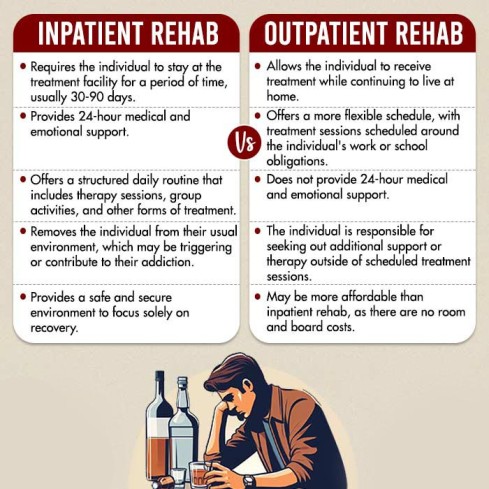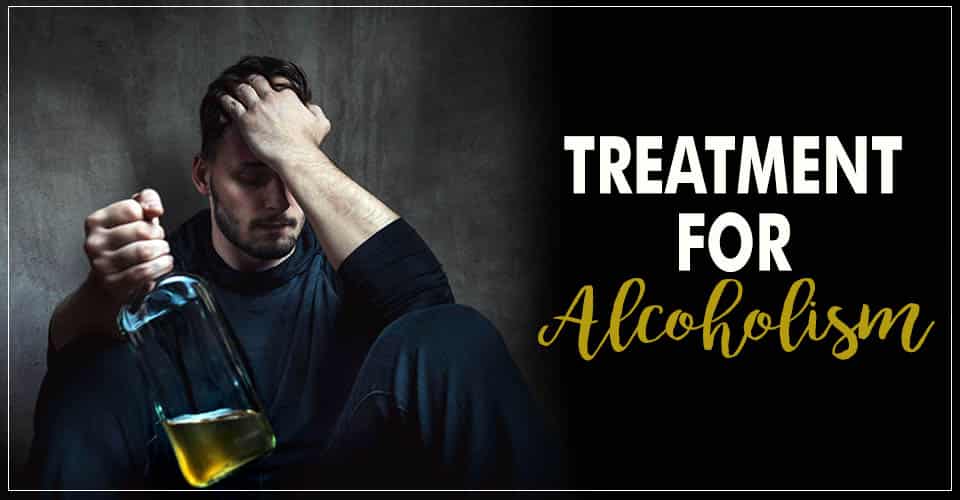Alcohol dependency or alcoholism is a progressive mental health condition marked by the excessive consumption of alcohol that disrupts an individual’s physical, social, and psychological well-being. Acknowledging and working with the existence of an alcohol-related problem is the initial step toward treatment for alcoholism.
Treatment And Recovery From Alcoholism
The best treatment for alcoholism typically employs a customized combination of approaches 1 Witkiewitz, K., Litten, R. Z., & Leggio, L. (2019). Advances in the science and treatment of alcohol use disorder. Science advances, 5(9), eaax4043. https://doi.org/10.1126/sciadv.aax4043 to suit the individual’s particular requirements and situation. The first step in the treatment process is detoxification or the elimination of alcohol from the body.
Afterward, patients may receive a variety of behavioral therapies and medications. They are also encouraged to cultivate other healthy coping strategies during the phases of recovery.

Methods Of Treatment For Alcoholism
Evidence-based treatment for alcoholism commonly includes 2 Huebner, R. B., & Kantor, L. W. (2011). Advances in alcoholism treatment. Alcohol research & health : the journal of the National Institute on Alcohol Abuse and Alcoholism, 33(4), 295–299. :
I. Psychotherapies
Counseling and therapy comprise the most effective treatment for alcoholism, providing support and guidance for individuals in recovery. The primary goal of therapy is to help individuals develop coping skills and prevent relapse. There are several psychological counseling methods that can be used to achieve this, including:
1. Cognitive-behavioral therapy (CBT)
This therapy focuses on identifying negative thoughts and behaviors related to alcohol use and replacing them with healthier coping mechanisms.
Read More About CBT Here
2. Dialectical-behavioral therapy (DBT)
This therapy helps individuals regulate their emotions, improve interpersonal relationships, and develop mindfulness skills to prevent relapse.
3. Motivational enhancement therapy (MET)
This short-term therapy helps individuals identify and strengthen their motivation and self-compassion to change their drinking behavior
4. Contingency management
This approach involves rewarding individuals for positive behaviors related to sobriety, such as refraining from alcohol consumption, attending support group meetings, or passing drug tests 3 Petry N. M. (2011). Contingency management: what it is and why psychiatrists should want to use it. The psychiatrist, 35(5), 161–163. https://doi.org/10.1192/pb.bp.110.031831 .
5. Family therapy
Family therapy involves holding therapeutic sessions with the affected individuals’ near and dear ones. This therapy aims to improve communication, resolve interpersonal conflicts, as well as strengthen bonding to create a strong support system (for the patient) in the long run.
6. Group Therapy
This form of psychotherapy involves a therapist leading a group of individuals in recovery from alcoholism. In this setting, group members can share their experiences, offer support, and learn from one another. It can also provide a safe and supportive environment for individuals to practice new coping skills and behaviors.
Read More About Group Therapy Here
7. 12-Step Programs
This type of group program is based on the belief that addiction is a disorder that affects both the mind and the body, and that recovery requires spiritual healing and growth. It involves admitting powerlessness over alcohol, surrendering to a higher power, as well as taking personal responsibility and making amends for past actions.
8. Other therapies
Performing arts-based therapies such as music, art, and drama therapies have proven to be effective in the treatment of addiction when used in conjunction with traditional behavioral therapies.
These therapies provide a safe and supportive environment for individuals to freely express their thoughts and feelings associated with alcoholism or other stressors.
By using creative outlets, individuals can explore their emotions and experiences in a non-confrontational manner and can gain a better understanding of their addiction and its underlying causes.
II. Pharmacotherapy
Medication treatment for alcoholism is often administered in conjunction with therapies (like CBT or group therapy), as part of a comprehensive treatment plan and under the guidance of a healthcare professional. Common drugs 4 Kranzler, H. R., & Soyka, M. (2018). Diagnosis and Pharmacotherapy of Alcohol Use Disorder: A Review. JAMA, 320(8), 815–824. https://doi.org/10.1001/jama.2018.11406 used to manage alcohol cravings and withdrawal symptoms include:
- Naltrexone, which blocks the euphoric effects of alcohol and reduces cravings
- Acamprosate, which helps to reduce cravings and restore the brain’s balance of chemicals that are disrupted by alcoholism.
- Disulfiram, which produces unpleasant side effects (such as nausea and vomiting) when alcohol is consumed, thereby serving as a deterrent to drinking.
- Gabapentin, an anticonvulsant medication that can help to reduce alcohol cravings and improve sleep.
- Antidepressants, which can be used to treat underlying mental health conditions 5 Graham, K., & Massak, A. (2007). Alcohol consumption and the use of antidepressants. CMAJ : Canadian Medical Association journal = journal de l’Association medicale canadienne, 176(5), 633–637. https://doi.org/10.1503/cmaj.060446 (like depression or anxiety) that may contribute to alcohol use disorder.
III. Rehabilitation
Rehabilitation is an important component of long-term treatment for alcoholism, including a range of interventions designed to help individuals recover from alcohol dependence 6 McKay, J. R., & Hiller-Sturmhofel, S. (2011). Treating alcoholism as a chronic disease: approaches to long-term continuing care. Alcohol research & health : the journal of the National Institute on Alcohol Abuse and Alcoholism, 33(4), 356–370. and rebuild their lives.
Rehabilitation centers 7 Center for Substance Abuse Treatment. (2018). Chapter 5—Specialized Substance Abuse Treatment Programs. Nih.gov; Substance Abuse and Mental Health Services Administration (US). Available from: https://www.ncbi.nlm.nih.gov/books/NBK64815/ are structured environments wherein an alcoholic undergoes a medical detox phase to safely remove alcohol and toxins from the body under medical supervision.
Rehabilitation programs are of two types. Inpatient rehabilitation is the most intensive form of care for severe alcoholism, where the patient stays in the center for 30, 60, or 90 days.
Outpatient rehabilitation is less strict and requires the patient to spend 10-12 hours a week at the facility, which is quite ideal for mild addiction. Nowadays, online counseling for alcoholism is also an integral form of rehab and detox programs.
Self-help Strategies For Coping With Alcoholism
Consider the following self-help coping strategies 8 Research refines alcoholism treatment options. (2000). Alcohol research & health : the journal of the National Institute on Alcohol Abuse and Alcoholism, 24(1), 53–61. during alcoholism treatment and recovery:
- Seek professional help and consider medication-assisted treatment.
- Participate in support group meetings.
- Develop a strong support system that will address your psychological needs throughout treatment and recovery.
- Avoid situations or people that may trigger alcohol cravings, such as bars or social events where alcohol is served.
- Establish clear, healthy boundaries with friends or family members who may enable or encourage alcohol use.
- Practice self-compassion and avoid self-blame or shame for past mistakes.
- Practice self-care by following a healthy diet and sleep schedule, exercising regularly, and practicing stress-management techniques like meditation or yoga.
- Staying engaged in enjoyable leisure activities like gratitude journaling, gardening, etc.
- Stay committed to sobriety.
Takeaway
Recovery from alcoholism is a challenging, lifelong process that requires determination to remain sober, even in the face of relapses or temptations. Treatment options such as therapy, medications, or rehab facilities can be effective in helping individuals recover from alcoholism.
However, it is important to recognize that alcoholism can also lead to a range of medical complications that may require professional medical attention. Ultimately, a combination of ongoing support, self-care, and a commitment to sobriety is key to achieving and maintaining recovery from alcoholism.
At A Glance
- The treatment for alcoholism typically involves a combination of medical, behavioral, and social interventions to help individuals achieve and maintain sobriety.
- The initial steps in the treatment process involve an acknowledgment of alcohol addiction, availing medical help, and detoxification.
- The next step involves a variety of behavioral therapies, medications, and healthy coping strategies.
- Online treatment for alcoholism may include online counseling, telemedicine, and Internet-based self-help resources.
- Severe cases of alcoholism may involve inpatient treatment programs in rehabilitation centers.
- A crucial component of recovery or aftercare involves attending support groups to prevent relapse and maintain sobriety.















